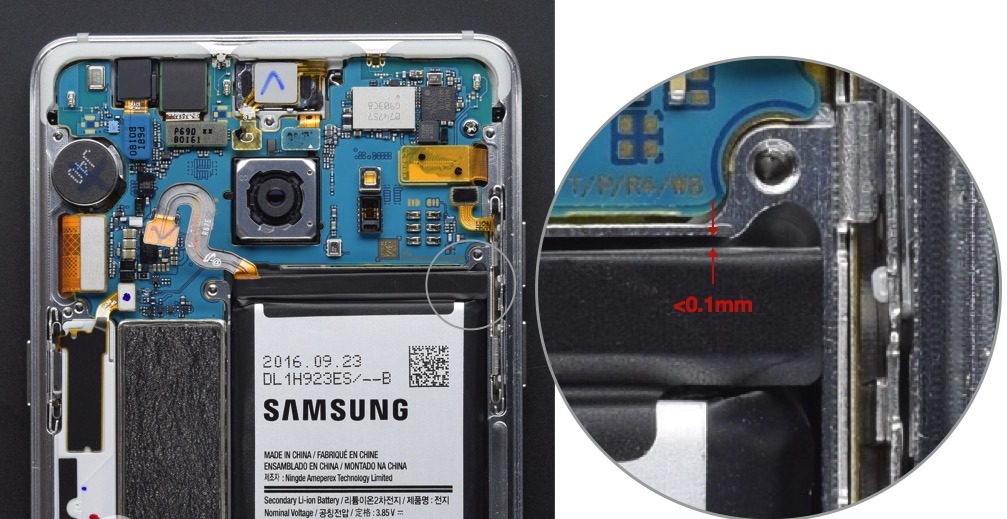An independent analysis of the Galaxy Note 7 suggests that Samsung engineered the device too tightly, and failed to give the battery any buffer between it and the surrounding metal of the case, which lead to the conflagrations experienced by more than 100 users in the summer and early fall.
As a result of the too-tight tolerances, the slightest expansion of the battery or contact between the battery and the enclosure from external forces appears to inevitably impinge on the battery's membrane, or compress it so tightly that the positive and negative terminal plates inside the battery would touch. The resulting energy discharge appears to be what caused the fires in the device.
However, the engineers don't believe that choices that led to the design flaw were all by accident.
"The battery also sits within a CNC-machined pocket — a costly choice likely made to protect it from being poked by other internal components." said Instrumental regarding the battery mount. "Samsung engineers were clearly trying to balance the risk of a super-aggressive manufacturing process to maximize capacity, while attempting to protect it internally."
"They shipped a dangerous product." - Instrumental on the Galaxy Note 7
The machined pocket was intended to protect the relatively softer battery membrane from the rough edges of the circuit board. As a result of inclusion, the widest gaps between the battery and the edge of the case was 0.5mm, with one part of the battery nearly in contact with the battery frame, measured at less than 0.1mm.
The disassembly also showed that there was no "ceiling" above the battery at all, with no apparent swell developed in the sacrificial unit. In the iPhone, and similar, safe, devices, there is at least a 0.5mm ceiling above the battery to allow for the normal expansion of the battery over time.
Instrumental believes that had the devices not been totally recalled, nearly all the phones would have been burst open by battery swell given enough charge and discharge cycles.
While the engineers performing the tear-down weren't present during the design process, they theorize that the battery manufacturing process was changing during the development of the Galaxy Note 7, and the newest versions that originally shipped with the phones "weren't tested with the same rigor" as sample phones built before mass-manufacturing began.
"In this case, Samsung took a deliberate step towards danger, and their existing test infrastructure and design validation process failed them," claimed Instrumental. "They shipped a dangerous product."
Still no solid data from Samsung
Samsung has not as of yet publicly declared what the engineering problem with the Galaxy Note 7 was. The company has not said much more about the issue than it said when it stopped production in October of the device, and issued a world-wide recall of the phone.
"We recently readjusted the production volume for thorough investigation and quality control, but putting consumer safety as top priority, we have reached a final decision to halt production of Galaxy Note 7s," Samsung said in the October recall statement. "For the benefit of consumers' safety, we stopped sales and exchanges of the Galaxy Note 7 and have consequently decided to stop production."
After the first wave of failures, employees involved in the post-recall testing claimed that they were required to keep communications about the evaluation process offline, with e-mails and other accountable forms of communication forbidden. Samsung allegedly feared lawsuits and subpoenas as a result of the fires, leading to the drastic restrictions on staff.
Samsung drew complaints from the CPSC in how it handled the initial "voluntary recall" of the device. Samsung reports that it is "fully cooperating" with the CPSC at this time to work out what happened, and to ensure that it doesn't happen again in other devices.
AppleInsider has learned that unreturned Galaxy Note 7 devices are still causing fires, with a CPSC employee telling us that there have been "more than 10" fires since the full recall, all caused by hold-outs refusing to return the devices.
In late November, Samsung issued a statement declaring that the Galaxy S7 family was safe, after a handful of device fires tied to the S7 and S7 Edge were reported to media.
 Mike Wuerthele
Mike Wuerthele







-m.jpg)






 Malcolm Owen
Malcolm Owen
 William Gallagher
William Gallagher
 Charles Martin
Charles Martin
 Christine McKee
Christine McKee
 Wesley Hilliard
Wesley Hilliard

 Andrew Orr
Andrew Orr








15 Comments
Independent research because Samsung still doesn't give a sh** about their customers.
This makes the design of replacement phones even stranger. This was suspected as a cause at the time, so why did they not use a smaller battery in the replacement units?
Interesting comment about over time all phones may have failed. Without knowing the issue, Samsung knew there was a growing issue or they would not have recalled considering how costly it is to recall devices.